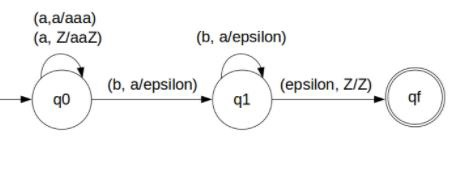
 Data Structure
Data Structure Networking
Networking RDBMS
RDBMS Operating System
Operating System Java
Java MS Excel
MS Excel iOS
iOS HTML
HTML CSS
CSS Android
Android Python
Python C Programming
C Programming C++
C++ C#
C# MongoDB
MongoDB MySQL
MySQL Javascript
Javascript PHP
PHP
- Selected Reading
- UPSC IAS Exams Notes
- Developer's Best Practices
- Questions and Answers
- Effective Resume Writing
- HR Interview Questions
- Computer Glossary
- Who is Who
Construct a DPDA for anb2n n ≥ 1 in TOC
A deterministic finite automata (DFA) can remember a finite amount of information but A push down automata (PDA) can remember an infinite amount of information.
Basically a PDA is as follows −
“Finite state machine+ a stack”
PDA has three components, which is as follows −
- An Input tape
- A control unit
- A Stack with infinite size
A PDA can be formally described as seven tuples (Q, Σ,S, δ,q0,I,F)
- Q is finite number of states
- Σ is input alphabet
- S is stack symbol
- Δ is the transition function: QX(Σ∪{e})XSXQ
- q0 is the initial state (q0 belongs to Q)
- I is the initial state top symbol
- F is a set of accepting states
Problem
Construct PDA for anb2n n ≥ 1.
Solution
So, the strings which are generated by the given language are as follows −
L={abb,aabbbb,aaabbbbbb,….}
Here a’s are followed by double the b’s
Whenever ‘a’ comes, push ‘a’ two times in the stack and if ‘a’ comes again then do the same.
When ‘b’ comes then pop one ‘a’ from the stack each time. Note that b comes after ‘a’.
Finally at the end of the strings, if nothing is left in the STACK, then we can declare that language is accepted in the PDA.
The PDA for the problem is as follows −

Transition functions
The transition functions are as follows −
Step 1: δ(q0, a, Z) = (q0, aaZ)
Step 2: δ(q0, a, a) = (q0, aaa)
Step 3: δ(q0, b, a) = (q1, ε)
Step 4: δ(q1, b, a) = (q1, ε)
Step 5: δ(q1, ε, Z) = (qf, Z)
Explanation
Step 1 − Consider input string: "aabbbb" which satisfies the given condition.
Step 2 − Scan string from left to right.
Step 3 − For input 'a' and STACK alphabet Z, then
Step 4 − For input 'a' and STACK alphabet 'a', then
Push the two 'a's into STACK: (a,a/aaa) and state will be q0. Now the STACK has "aaaa".
Step 5 − For input 'b' and STACK alphabet 'a', then
Pop one 'a' from STACK: (b,a/ε) and state will be q1.
Step 6 − For input 'b' and STACK alphabet 'a' and state q1, then
Pop one 'a' from STACK: (b,a/ε) and state will remain q1
Step 7 − For input 'b' and STACK alphabet 'a', then
Pop one 'a' from STACK: (b,a/ε) and state will be q1
Step 8 − For input 'b' and STACK alphabet 'a' and state q1, then
Pop one 'a' from STACK: (b,a/ε) and state will remain q1
Step 9 − We reached end of the string, for input ε and STACK alphabet Z,
Go to final state(qf): (ε, Z/Z)

